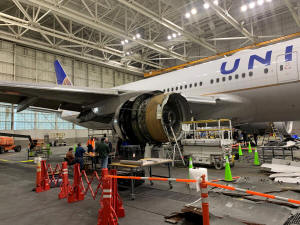United 777 plane flew fewer than half the flights allowed between
checks: sources
 Send a link to a friend
Send a link to a friend
 [February 25, 2021]
By David Shepardson [February 25, 2021]
By David Shepardson
WASHINGTON (Reuters) - A United Airlines
plane with a Pratt & Whitney engine that failed on Saturday had flown
fewer than half the flights allowed by U.S. regulators between fan blade
inspections, two sources with knowledge of the matter said.
The Boeing Co 777 plane had flown nearly 3,000 cycles, equivalent to one
take-off and landing, which compares to the checks every 6,500 cycles
mandated after a separate United engine incident in 2018, said the
sources.
They sought anonymity as they were not authorized to speak publicly.
United declined to comment.
Pratt, the maker of the PW4000 engines, advised airlines on Monday to
step up checks to every 1,000 cycles, in a bulletin seen by Reuters. It
did not immediately respond to a request for comment.

On Tuesday, the U.S. Federal Aviation Administration said it was
ordering immediate inspections of 777 planes with PW4000 engines before
they could return to flight, going further than Pratt.
The engines are used on 128 older versions of the plane, accounting for
less than 10% of the more than 1,600 777s delivered and only a handful
of airlines in the United States, South Korea and Japan were operating
them recently.
Japan and South Korea have also grounded the planes for fan blade
checks.
On Monday, the FAA acknowledged that after a Japan Airlines (JAL) PW4000
engine incident in December it had been considering stepping up blade
inspections that use thermal acoustic imaging to find signs of metal
fatigue.
[to top of second column]
|

The damaged starboard engine of United Airlines flight 328, a Boeing
777-200, is seen following a Feb. 20 engine failure incident, in a
hangar at Denver International Airport in Denver, Colorado, U.S.
February 22, 2021. National Transportation Safety Board/Handout via
REUTERS.

A risk-assessment meeting was held last week to discuss the issue
before the United engine failed on Saturday, one of the sources
said, confirming an earlier report by CNN. No decision had been
imminent ahead of the United incident, the source added.
A spokeswoman for Pratt, owned by Raytheon Technologies, said on
Wednesday that fan blades would need to be shipped to its repair
station in East Hartford, Connecticut, for the latest inspections,
including those from Japan and South Korea.
Each engine has 22 blades that must be removed individually and each
will take eight hours to inspect, FAA Administrator Steve Dickson
told Bloomberg TV on Wednesday.
That is the equivalent of 352 hours of work per plane, as each 777
has two engines. Boeing said 69 of the planes were in active service
before Saturday's incident, while 59 had been grounded amid low
demand during the pandemic.
Pratt did not respond to questions about how many engines it could
inspect per month. United has not commented on how long it expects
the inspections to take, while JAL and ANA Holdings said the timing
was unclear.
(Reporting by David Shepardson in Washington; additional reporting
by Tim Kelly in Tokyo writing by Jamie Freed. Editing by Gerry
Doyle)
[© 2021 Thomson Reuters. All rights
reserved.] Copyright 2021 Reuters. All rights reserved. This material may not be published,
broadcast, rewritten or redistributed.
Thompson Reuters is solely responsible for this content. |